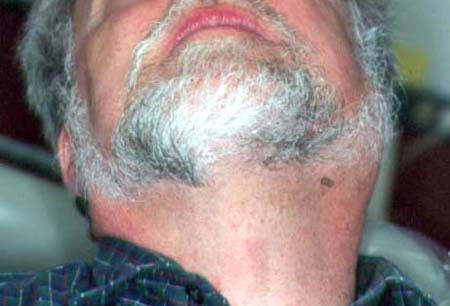Resumo
Definição
História e exame físico
Principais fatores diagnósticos
- febre
- dor e disfagia
- edema facial
- edemas doloridos recorrentes
- exsudatos de pus pela abertura da glândula salivar
- uso de medicamentos xerostômicos
- trismos mandibulares
- dificuldade respiratória (estridor, uso de músculos acessórios, batimento da asa do nariz, sibilo)
- paralisia do nervo craniano
- doença do tecido conjuntivo ou síndrome de Sjögren
Outros fatores diagnósticos
- edema episódico durante a alimentação
- recentes intervenções cirúrgicas sob anestesia geral
- ressecamento dos olhos e da boca
- candidíase oral
- exposição ao contraste iodado
- edemas indolores recorrentes
- deslocamento do lobo auricular
- pródromo de parestesia na glândula afetada
- edema no palato duro
Fatores de risco
- depleção de volume e desnutrição
- imunossupressão
- Síndrome de Sjögren
- doenças do tecido conjuntivo
- mulheres entre 50 e 60 anos de idade
- anestesia geral
- medicamentos xerostômicos
- sialolitíase
- obstrução mecânica crônica e/ou múltiplos episódios de inflamação aguda
- trauma (morder a bochecha)
- procedimentos ortodônticos/dentários
- sialectase, diverticulite e estenoses
Investigações diagnósticas
Primeiras investigações a serem solicitadas
- cultura e sensibilidades do exsudato do ducto
- Hemograma completo
- radiografias faciais (filmes oclusais e/ou dos tecidos moles)
Investigações a serem consideradas
- ultrassonografia da glândula afetada
- Tomografia computadorizada (TC)
- sialografia digital por subtração
- Sialografia por ressonância magnética (RM)
- cintilografia usando radioisótopo pertecnetato Tc 99m de sódio
- anticorpos anti-SSA/Ro, anti-SSB/La
- fator antinuclear
- fator reumatoide
- citologia por aspiração com agulha fina (FNAC) da glândula afetada
- RNM
- biópsia das glândulas salivares menores
- IgG4 e IgE
- biópsia das glândulas salivares maiores
- sialoendoscopia
Algoritmo de tratamento
sinais de comprometimento das vias aéreas
sialadenite bacteriana aguda (não obstrutiva)
sialadenite obstrutiva
sialadenite autoimune
sialadenite necrosante subaguda
sialadenite crônica: recorrente ou esclerosante (<3 vezes/ano ou não grave)
sialadenite recorrente: qualquer causa (>3 vezes/ano ou ataques graves)
Colaboradores
Autores
Chris Avery, MD, MChir, FDSRCS, FRCS, FRCS (OMFS)
Consultant Oral and Maxillofacial Surgeon
Honorary Associate Professor Senior Lecturer
University Hospitals of Leicester NHS Trust
Leicester
UK
Declarações
CA declares that he has no competing interests.
Agradecimentos
Dr Chris Avery would like to gratefully acknowledge Dr Alfredo Aguirre, Dr Michael N. Hatton, and Dr Ernesto de Nardin, previous contributors to this topic. AA, MNH, and EDN declare that they have no competing interests.
Peer reviewers
Issac van der Waal, DDS, PhD
Professor of Oral Pathology
Head of the Department of Oral and Maxillofacial Surgery and Oral Pathology
VU University Medical Centre and Academic Centre for Dentistry
Amsterdam
The Netherlands
Disclosures
IVDW declares that he has no competing interests.
Michael D. Turner, DDS, MD, FACS
Assistant Professor
New York University College of Dentistry
Department of Oral and Maxillofacial Surgery
Department of Periodontics and Implant Dentistry
New York University School of Medicine
New York
NY
Disclosures
MDT declares that he has no competing interests.
Peer reviewer acknowledgements
BMJ Best Practice topics are updated on a rolling basis in line with developments in evidence and guidance. The peer reviewers listed here have reviewed the content at least once during the history of the topic.
Disclosures
Peer reviewer affiliations and disclosures pertain to the time of the review.
References
Key articles
Fattahi TT, Lyu PE, Van Sickels JE. Management of acute suppurative parotitis. J Oral Maxillofac Surg. 2002;60:446-448. Abstract
Kraaij S, Karagozoglu KH, Forouzanfar T, et al. Salivary stones: symptoms, aetiology, biochemical composition and treatment. Br Dent J. 2014 Dec 5;217(11):E23.Full text Abstract
Reference articles
A full list of sources referenced in this topic is available to users with access to all of BMJ Best Practice.

Differentials
- Caxumba
- Sarcoidose
- Tuberculose
More DifferentialsGuidelines
- Updated S2K AWMF guideline for the diagnosis and follow-up of obstructive sialadenitis - relevance for radiologic imaging
- Salivary gland disorders
More GuidelinesPatient information
Artrite reumatoide
Sarampo, caxumba e rubéola: meu filho deve tomar a vacina tríplice viral?
More Patient informationLog in or subscribe to access all of BMJ Best Practice
Use of this content is subject to our disclaimer